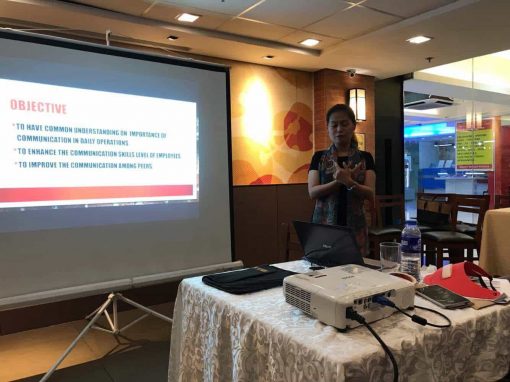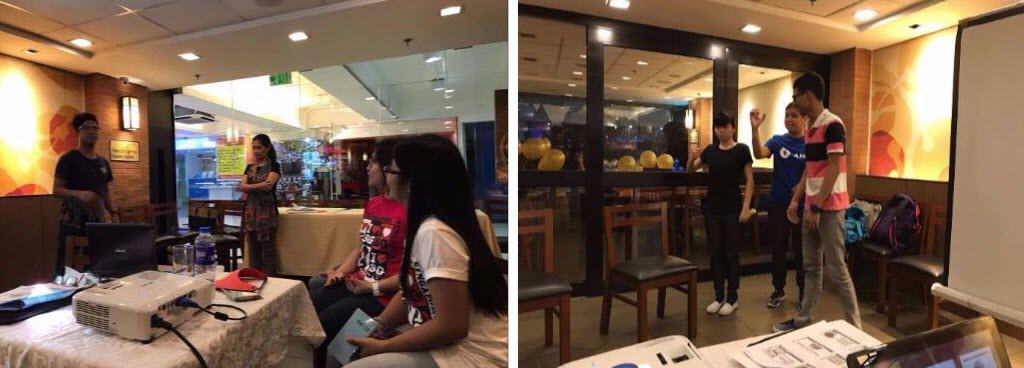Communication 101
Having seminars is one way of helping the team build a healthy relationship towards each other. One component that builds up a team is to have effective communication. But let’s define it first. According to the internet, communication is imparting or exchanging of information or news. It’s a successful conveying or sharing of ideas and feelings. But the question is, do we have effective communication?
For the nth time, Team Awesome had attended a seminar again last October 13, 2017, at Max’s Checkpoint Mall in Calamba, Laguna. But before we proceeded into the topic, the team had their lunch first. Everyone enjoyed the rice bowls and the desserts that were served to us. We made sure that we were full and energized by the food we had so that we can actively listen and participate in the seminar.

The main topic of the seminar was about communication, and its objective is, to have a common understanding of the importance of communication in daily operations, to enhance the communication skills level of employees and to improve the communication among peers. Ms. Sugus, the speaker of the seminar, explained it very well to us. And she said that feedback also helps the communicators make sure that the message has been decoded correctly.


As part of the seminar’s agenda, Ms. Sugus prepared three activities for the team related to the topic, which is communication. She divided the team first into two groups consisting of four members. The first activity was the popular Pinoy game which is “Pinoy Henyo,” but during our seminar, it was entitled as “Portal Henyo.” The mechanics of the game is, there were two players. The 1st player is the one to correctly identify the word in his/her head by asking categories related to it. While the 2nd player answers the 1st player by saying yes, no and maybe with a time limit of 60 seconds. Each group plays it very competitively; no one wanted to lose. Only one group go the correct word, but some weren’t able to answer the word within the given time.
For the second activity, it was a popular game called “Charades.” One representative of the group was going to act out the given words without uttering sounds or saying words. The rest of the group members will be the one to guess it for 60 seconds. It was very fun and exciting activity, at the same time it was very frustrating if the group members can’t guess the word right. But during this activity, both teams scored a point.
Last activity was also a charade, but this time, the representative from the group will be the one to guess the word, and the rest of the members were going to act out the word/s to be guessed. It was easy for the representative to guess the word since there are many of them who were doing the acting.


These activities were really fun, enjoyable and challenging. But it also showed how communications are present in each group. The 1st group, when they were doing the group charade they talked first before they acted out, but the 2nd group, once they saw the word they immediately acted out that’s why the one who did the guessing was so confused on who he/she should watch while acting, because the group members were not consistent with their actions not like the first group. Teamwork can also be shown in the 1st group.
The activities also let us reflect on how communication is very important. The sender should always be observant in the receiver’s perspective. The sender should also be sensitive. Not because the sender understands the message he/she is conveying, the receiver can automatically pick up. He/she should also consider the receiver’s limitations.
After the activities, we discussed the different barriers of effective communication. Most common communication barriers are language, psychological, physical, systematic and attitudinal barriers. We should always consider what possible barriers the person we are talking to has. And we should always remember that effective communication builds through questions, listening actively and restating & confirming the information received. Once we are asked, or someone is sharing information, we should listen actively by paying attention and giving respect to the speaker. Attentive listening also includes eye contact, and gestures. We should always have a reflection that includes restating what you have heard and confirming it to the sender. In that way, you are showing the sender that you truly understood what has been said.
Communication
Successful conveying or sharing of ideas and feelings; exchanging of information or news.
Barriers
Most common communication barriers are language, psychological, physical, systematic and attitudinal barriers.
Listening
One component of effective communication. It includes eye contact, posture, facial expressions, gestures and genuine interest in what the person is saying.